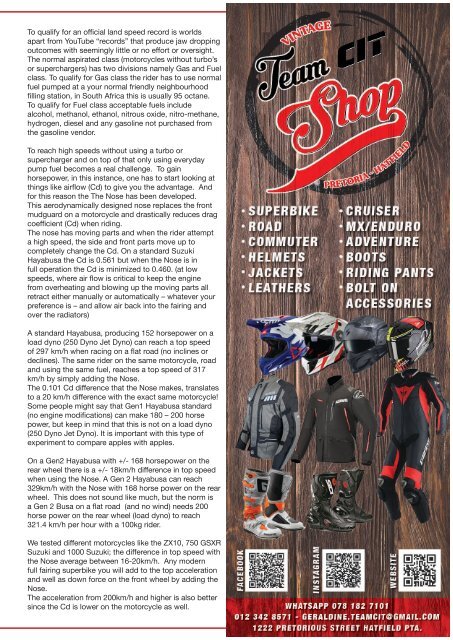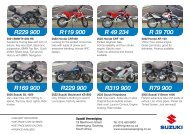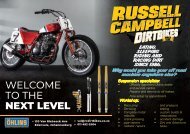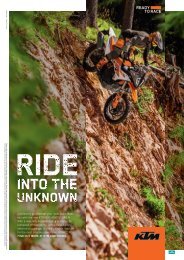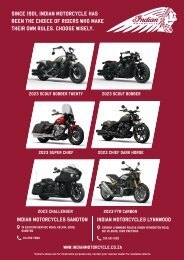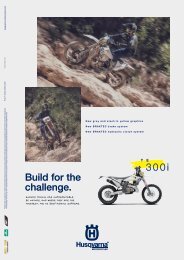RideFast JUNE 2021
You also want an ePaper? Increase the reach of your titles
YUMPU automatically turns print PDFs into web optimized ePapers that Google loves.
To qualify for an official land speed record is worlds<br />
apart from YouTube “records” that produce jaw dropping<br />
outcomes with seemingly little or no effort or oversight.<br />
The normal aspirated class (motorcycles without turbo’s<br />
or superchargers) has two divisions namely Gas and Fuel<br />
class. To qualify for Gas class the rider has to use normal<br />
fuel pumped at a your normal friendly neighbourhood<br />
filling station, in South Africa this is usually 95 octane.<br />
To qualify for Fuel class acceptable fuels include<br />
alcohol, methanol, ethanol, nitrous oxide, nitro-methane,<br />
hydrogen, diesel and any gasoline not purchased from<br />
the gasoline vendor.<br />
To reach high speeds without using a turbo or<br />
supercharger and on top of that only using everyday<br />
pump fuel becomes a real challenge. To gain<br />
horsepower, in this instance, one has to start looking at<br />
things like airflow (Cd) to give you the advantage. And<br />
for this reason the The Nose has been developed.<br />
This aerodynamically designed nose replaces the front<br />
mudguard on a motorcycle and drastically reduces drag<br />
coefficient (Cd) when riding.<br />
The nose has moving parts and when the rider attempt<br />
a high speed, the side and front parts move up to<br />
completely change the Cd. On a standard Suzuki<br />
Hayabusa the Cd is 0.561 but when the Nose is in<br />
full operation the Cd is minimized to 0.460. (at low<br />
speeds, where air flow is critical to keep the engine<br />
from overheating and blowing up the moving parts all<br />
retract either manually or automatically – whatever your<br />
preference is – and allow air back into the fairing and<br />
over the radiators)<br />
A standard Hayabusa, producing 152 horsepower on a<br />
load dyno (250 Dyno Jet Dyno) can reach a top speed<br />
of 297 km/h when racing on a flat road (no inclines or<br />
declines). The same rider on the same motorcycle, road<br />
and using the same fuel, reaches a top speed of 317<br />
km/h by simply adding the Nose.<br />
The 0.101 Cd difference that the Nose makes, translates<br />
to a 20 km/h difference with the exact same motorcycle!<br />
Some people might say that Gen1 Hayabusa standard<br />
(no engine modifications) can make 180 – 200 horse<br />
power, but keep in mind that this is not on a load dyno<br />
(250 Dyno Jet Dyno). It is important with this type of<br />
experiment to compare apples with apples.<br />
.<br />
On a Gen2 Hayabusa with +/- 168 horsepower on the<br />
rear wheel there is a +/- 18km/h difference in top speed<br />
when using the Nose. A Gen 2 Hayabusa can reach<br />
329km/h with the Nose with 168 horse power on the rear<br />
wheel. This does not sound like much, but the norm is<br />
a Gen 2 Busa on a flat road (and no wind) needs 200<br />
horse power on the rear wheel (load dyno) to reach<br />
321.4 km/h per hour with a 100kg rider.<br />
We tested different motorcycles like the ZX10, 750 GSXR<br />
Suzuki and 1000 Suzuki; the difference in top speed with<br />
the Nose average between 16-20km/h. Any modern<br />
full fairing superbike you will add to the top acceleration<br />
and well as down force on the front wheel by adding the<br />
Nose.<br />
The acceleration from 200km/h and higher is also better<br />
since the Cd is lower on the motorcycle as well.<br />
RIDEFAST MAGAZINE <strong>JUNE</strong> <strong>2021</strong> 55


